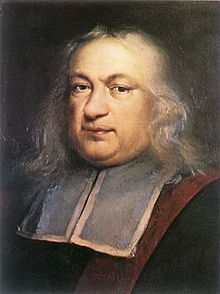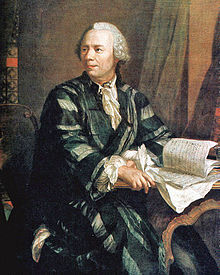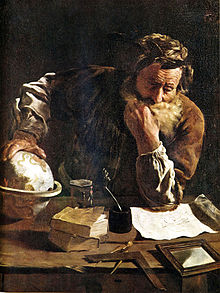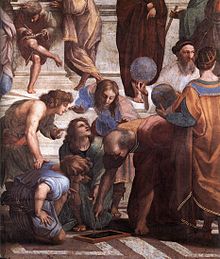 Sir Isaac Newton PRS MP (25 December 1642 – 20 March 1727) was an English physicist and mathematician who is widely regarded as one of the most influential scientists of all time and as a key figure in the scientific revolution. His book Philosophiæ Naturalis Principia Mathematica (“Mathematical Principles of Natural Philosophy”), first published in 1687, laid the foundations for most of classical mechanics. Newton also made seminal contributions to optics and shares credit with Gottfried Leibniz for the invention of the infinitesimal calculus.
Sir Isaac Newton PRS MP (25 December 1642 – 20 March 1727) was an English physicist and mathematician who is widely regarded as one of the most influential scientists of all time and as a key figure in the scientific revolution. His book Philosophiæ Naturalis Principia Mathematica (“Mathematical Principles of Natural Philosophy”), first published in 1687, laid the foundations for most of classical mechanics. Newton also made seminal contributions to optics and shares credit with Gottfried Leibniz for the invention of the infinitesimal calculus.
Newton’s Principia formulated the laws of motion and universal gravitation that dominated scientists’ view of the physical universe for the next three centuries. It also demonstrated that the motion of objects on the Earth and that of celestial bodies could be described by the same principles. By deriving Kepler’s laws of planetary motion from his mathematical description of gravity, Newton removed the last doubts about the validity of the heliocentric model of the cosmos.
Newton built the first practical reflecting telescope and developed a theory of colour based on the observation that a prism decomposes white light into the many colours of the visible spectrum. He also formulated an empirical law of cooling and studied the speed of sound. In addition to his work on the calculus, as a mathematician Newton contributed to the study of power series, generalised the binomial theorem to non-integer exponents, and developed Newton’s method for approximating the roots of a function.
Newton was a fellow of Trinity College and the second Lucasian Professor of Mathematics at the University of Cambridge. He was a devout but unorthodox Christian and, unusually for a member of the Cambridge faculty, he refused to take holy orders in the Church of England, perhaps because he privately rejected the doctrine of trinitarianism. In addition to his work on the mathematical sciences, Newton also dedicated much of his time to the study of alchemy and biblical chronology, but most of his work in those areas remained unpublished until long after his death. In his later life, Newton became president of the Royal Society. He also served the British government as Warden and Master of the Royal Mint.
Source: Wikipedia
Johann Carl Friedrich Gauss (/ɡaʊs/; German: Gauß, pronounced [ɡaʊs] (![]() listen); Latin: Carolus Fridericus Gauss) (30 April 1777 – 23 February 1855) was a German mathematician and physical scientist who contributed significantly to many fields, including number theory, algebra, statistics, analysis, differential geometry, geodesy, geophysics, electrostatics, astronomy and optics.
listen); Latin: Carolus Fridericus Gauss) (30 April 1777 – 23 February 1855) was a German mathematician and physical scientist who contributed significantly to many fields, including number theory, algebra, statistics, analysis, differential geometry, geodesy, geophysics, electrostatics, astronomy and optics.
Sometimes referred to as the Princeps mathematicorum[1] (Latin, “the Prince of Mathematicians” or “the foremost of mathematicians”) and “greatest mathematician since antiquity”, Gauss had a remarkable influence in many fields of mathematics and science and is ranked as one of history’s most influential mathematicians.[2] He referred to mathematics as “the queen of sciences”.
Source: Wikipedia
Euclid (/ˈjuːklɪd/ ewk-lid; Ancient Greek: Εὐκλείδης Eukleidēs), fl. 300 BC, also known as Euclid of Alexandria, was a Greek mathematician, often referred to as the “Father of Geometry”. He was active in Alexandria during the reign of Ptolemy I (323–283 BC). His Elements is one of the most influential works in the history of mathematics, serving as the main textbook for teaching mathematics(especially geometry) from the time of its publication until the late 19th or early 20th century.[1][2][3] In the Elements, Euclid deduced the principles of what is now called Euclidean geometry from a small set of axioms. Euclid also wrote works on perspective, conic sections,spherical geometry, number theory and rigor.”Euclid” is the anglicized version of the Greek name Εὐκλείδης, meaning “Good Glory”.
Source: Wikipedia
 Pierre de Fermat (French: [pjɛːʁ dəfɛʁma]; 17[2] August 1601 or 1607[3] – 12 January 1665) was a French lawyer at the Parlement ofToulouse, France, and an amateur mathematician who is given credit for early developments that led to infinitesimal calculus, including his technique of adequality. In particular, he is recognized for his discovery of an original method of finding the greatest and the smallestordinates of curved lines, which is analogous to that of the differential calculus, then unknown, and his research into number theory. He made notable contributions to analytic geometry, probability, and optics. He is best known for Fermat’s Last Theorem, which he described in a note at the margin of a copy of Diophantus‘ Arithmetica.
Pierre de Fermat (French: [pjɛːʁ dəfɛʁma]; 17[2] August 1601 or 1607[3] – 12 January 1665) was a French lawyer at the Parlement ofToulouse, France, and an amateur mathematician who is given credit for early developments that led to infinitesimal calculus, including his technique of adequality. In particular, he is recognized for his discovery of an original method of finding the greatest and the smallestordinates of curved lines, which is analogous to that of the differential calculus, then unknown, and his research into number theory. He made notable contributions to analytic geometry, probability, and optics. He is best known for Fermat’s Last Theorem, which he described in a note at the margin of a copy of Diophantus‘ Arithmetica.
Source: Wikipedia
 Leonhard Euler (/ˈɔɪlər/ oyl-ər;[2] German pronunciation: [ˈɔʏlɐ] (
Leonhard Euler (/ˈɔɪlər/ oyl-ər;[2] German pronunciation: [ˈɔʏlɐ] (![]() listen), local pronunciation: [ˈɔɪlr̩] (
listen), local pronunciation: [ˈɔɪlr̩] (![]() listen); 15 April 1707 – 18 September 1783) was a pioneering Swiss mathematician and physicist. He made important discoveries in fields as diverse as infinitesimal calculus and graph theory. He also introduced much of the modern mathematical terminology and notation, particularly for mathematical analysis, such as the notion of a mathematical function.[3] He is also renowned for his work in mechanics, fluid dynamics, optics, andastronomy. Euler spent most of his adult life in St. Petersburg, Russia, and in Berlin, Prussia. He is considered to be the pre-eminent mathematician of the 18th century, and one of the greatest mathematicians ever to have lived. He is also one of the most prolific mathematicians ever; his collected works fill 60–80 quarto volumes.[4] A statement attributed to Pierre-Simon Laplaceexpresses Euler’s influence on mathematics: “Read Euler, read Euler, he is the master of us all.”[5]
listen); 15 April 1707 – 18 September 1783) was a pioneering Swiss mathematician and physicist. He made important discoveries in fields as diverse as infinitesimal calculus and graph theory. He also introduced much of the modern mathematical terminology and notation, particularly for mathematical analysis, such as the notion of a mathematical function.[3] He is also renowned for his work in mechanics, fluid dynamics, optics, andastronomy. Euler spent most of his adult life in St. Petersburg, Russia, and in Berlin, Prussia. He is considered to be the pre-eminent mathematician of the 18th century, and one of the greatest mathematicians ever to have lived. He is also one of the most prolific mathematicians ever; his collected works fill 60–80 quarto volumes.[4] A statement attributed to Pierre-Simon Laplaceexpresses Euler’s influence on mathematics: “Read Euler, read Euler, he is the master of us all.”[5]
Source: Wikipedia
David Hilbert, ForMemRS[2] (German: [ˈdaːvɪt ˈhɪlbɐt]; January 23, 1862 – February 14, 1943) was a German mathematician. He is recognized as one of the most influential and universal mathematicians of the 19th and early 20th centuries. Hilbert discovered and developed a broad range of fundamental ideas in many areas, including invariant theory and the axiomatization of geometry. He also formulated the theory of Hilbert spaces,[3] one of the foundations offunctional analysis.
Hilbert adopted and warmly defended Georg Cantor‘s set theory and transfinite numbers. A famous example of his leadership in mathematics is his 1900 presentation of a collection of problems that set the course for much of the mathematical research of the 20th century.
Hilbert and his students contributed significantly to establishing rigor and developed important tools used in modern mathematical physics. Hilbert is known as one of the founders of proof theory and mathematical logic, as well as for being among the first to distinguish between mathematics and metamathematics.[4]
Source: Wikipedia

Archimedes of Syracuse (Greek: Ἀρχιμήδης; c. 287 BC – c. 212 BC) was a Greekmathematician, physicist, engineer, inventor, andastronomer.[1] Although few details of his life are known, he is regarded as one of the leading scientists in classical antiquity. Among his advances in physics are the foundations of hydrostatics, statics and an explanation of the principle of the lever. He is credited with designing innovative machines, including siege engines and the screw pump that bears his name. Modern experiments have tested claims that Archimedes designed machines capable of lifting attacking ships out of the water and setting ships on fire using an array of mirrors.[2]
Archimedes is generally considered to be the greatest mathematician of antiquity and one of the greatest of all time.[3][4] He used themethod of exhaustion to calculate the area under the arc of a parabola with the summation of an infinite series, and gave a remarkably accurate approximation of pi.[5] He also defined the spiral bearing his name, formulae for the volumes of solids of revolution, and an ingenious system for expressing very large numbers.
Archimedes died during the Siege of Syracuse when he was killed by a Roman soldier despite orders that he should not be harmed.Cicero describes visiting the tomb of Archimedes, which was surmounted by a sphere inscribed within a cylinder. Archimedes had proven that the sphere has two thirds of the volume and surface area of the cylinder (including the bases of the latter), and regarded this as the greatest of his mathematical achievements.
Unlike his inventions, the mathematical writings of Archimedes were little known in antiquity. Mathematicians from Alexandria read and quoted him, but the first comprehensive compilation was not made until c. 530 AD by Isidore of Miletus, while commentaries on the works of Archimedes written by Eutocius in the sixth century AD opened them to wider readership for the first time. The relatively few copies of Archimedes’ written work that survived through the Middle Ages were an influential source of ideas for scientists during theRenaissance,[6] while the discovery in 1906 of previously unknown works by Archimedes in the Archimedes Palimpsest has provided new insights into how he obtained mathematical results.[7]
Source: Wikipedia


